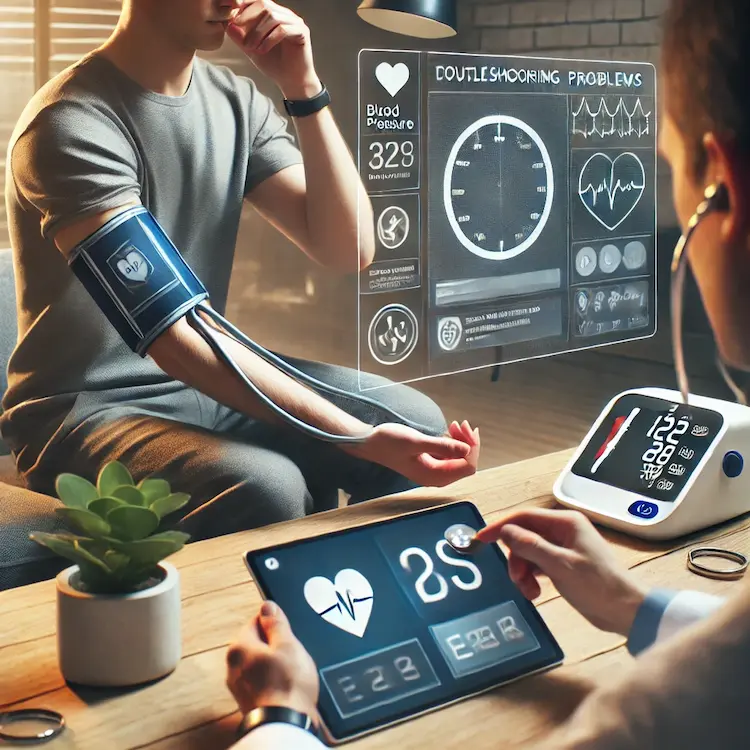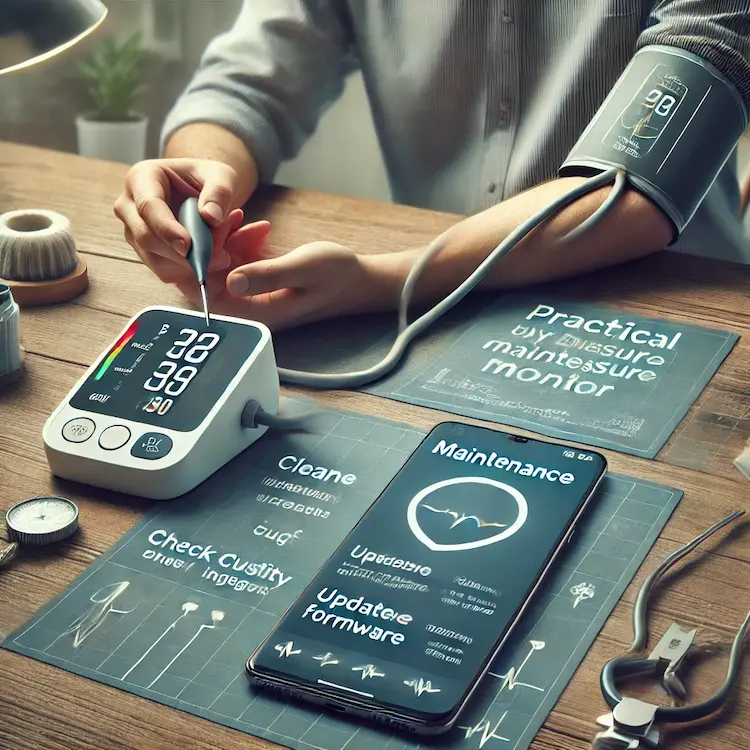Monitoring blood pressure is a critical aspect of managing cardiovascular health. However, like any medical device, blood pressure monitors can encounter issues that may compromise their accuracy and reliability. This article delves into the Troubleshooting common problems with blood pressure monitors, their potential health and societal impacts, and offers practical solutions to ensure accurate readings and effective hypertension management.
Importance of Blood Pressure Monitoring
Blood pressure monitoring plays a vital role in the early detection and management of hypertension, a condition that affects millions worldwide. Accurate blood pressure measurements enable individuals and healthcare professionals to make informed decisions regarding lifestyle changes and medication adjustments, thereby reducing the risk of heart disease, stroke, and other related complications.

Common Problems with Blood Pressure Monitors
Despite their essential role, blood pressure monitors can face several challenges that may lead to inaccurate readings or device malfunctions. Understanding these issues is crucial for users to troubleshoot effectively.
1. Inaccurate Readings
One of the most common problems is inaccurate blood pressure readings. Factors contributing to this issue include:
- Improper Cuff Size: Using a cuff that is too small or too large can skew results.
- Incorrect Placement: The cuff should be placed on the bare upper arm, not over clothing.
- Movement During Measurement: Talking or moving can interfere with accurate readings.
2. Cuff Issues
The cuff is a critical component of a blood pressure monitor. Common cuff-related problems include:
- Leaking Cuffs: Air leaks can prevent the cuff from inflating properly.
- Damaged Cuffs: Tears or worn-out materials can affect measurement accuracy.
- Improper Inflation: Cuffs that do not inflate to the necessary pressure can lead to false readings.
3. Device Malfunctions
Electronic blood pressure monitors can experience various malfunctions, such as:
- Battery Problems: Low or dead batteries can cause the device to malfunction or shut down.
- Display Errors: Faulty displays may not show readings correctly.
- Software Glitches: Firmware issues can disrupt the monitor’s functionality.
4. User Errors
User mistakes are a significant source of inaccurate blood pressure measurements. Common errors include:
- Incorrect Positioning: Sitting with poor posture or having the arm unsupported can affect readings.
- Failure to Rest: Not resting for a few minutes before taking a measurement can result in elevated readings.
- Multiple Readings: Taking several readings in quick succession without intervals can lead to inconsistent results.
5. Connectivity Problems
Modern blood pressure monitors often connect to smartphones or other devices for data tracking. Connectivity issues can arise due to:
- Bluetooth Interference: Other wireless devices can disrupt the connection.
- App Compatibility: Outdated or incompatible apps may fail to sync data properly.
- Firmware Updates: Missing updates can cause connectivity malfunctions.
Comparing Different Blood Pressure Monitor Types
Understanding the various types of blood pressure monitors can help users choose the right device and troubleshoot effectively.
| Type |
Pros |
Cons |
| Manual Monitors |
Highly accurate when used correctly |
Require training to use effectively |
| Automatic Monitors |
Easy to use with minimal training |
May be less accurate if not properly calibrated |
| Wrist Monitors |
Portable and convenient |
More sensitive to body position, less accurate |
| Upper Arm Monitors |
Generally more accurate and reliable |
Bulkier and less portable |
| Smartphone-Connected |
Allows for easy data tracking and sharing |
Dependent on device compatibility and battery life |
Each type contributes to broader understanding by catering to different user needs, preferences, and accuracy requirements. For instance, automatic monitors are ideal for home use, while manual monitors are preferred in clinical settings for their precision.
Practical Troubleshooting Tips
Ensuring accurate blood pressure measurements involves addressing common issues systematically. Here are practical steps to troubleshoot and maintain your blood pressure monitor:
1. Ensuring Proper Cuff Placement
- Select the Right Cuff Size: Measure your arm circumference and choose a cuff that fits snugly without being too tight or too loose.
- Position Correctly: Place the cuff on the bare upper arm at heart level. Ensure the artery marker aligns with the brachial artery.
2. Calibration Checks
- Regular Calibration: Periodically calibrate your monitor according to the manufacturer’s instructions to maintain accuracy.
- Professional Calibration: Have your device checked by a healthcare professional if you suspect calibration issues.
3. Regular Maintenance
- Clean the Device: Wipe the monitor and cuff regularly with a damp cloth to remove dirt and sweat.
- Inspect for Damage: Check for any wear and tear on the cuff and tubing. Replace damaged parts promptly.
4. Understanding Device Instructions
- Read the Manual: Thoroughly read the user manual to understand the correct operating procedures.
- Follow Guidelines: Adhere to the manufacturer’s guidelines for usage, maintenance, and storage.
5. Updating Firmware
- Check for Updates: Regularly check for firmware updates that can improve device functionality and fix known issues.
- Install Updates: Follow the manufacturer’s instructions to install updates safely.
Health and Societal Impacts
Accurate blood pressure monitoring has profound health and societal implications:
- Hypertension Management: Reliable measurements are essential for effective hypertension management, reducing the risk of heart attacks and strokes.
- Healthcare Costs: Preventing complications through accurate monitoring can lower healthcare costs by reducing hospital admissions and medical treatments.
- Public Health: Widespread access to accurate blood pressure monitors can improve overall public health outcomes by enabling early detection and intervention.
Relevant Statistics and Facts
- Prevalence of Hypertension: According to the World Health Organization, approximately 1.13 billion people worldwide have hypertension.
- Device Accuracy: Studies show that around 20% of home blood pressure monitors may provide inaccurate readings.
- Healthcare Savings: Effective hypertension management through accurate monitoring can save billions in healthcare costs annually.
Comparing Different Troubleshooting Tools
Different tools and approaches can aid in troubleshooting blood pressure monitors:
| Tool/Approach |
Function |
Contribution |
| Manufacturer Support |
Provides manuals, FAQs, and customer service |
Offers tailored solutions and expert guidance |
| Online Forums |
Community-based support and shared experiences |
Facilitates peer-to-peer troubleshooting |
| Calibration Services |
Professional calibration and maintenance services |
Ensures device accuracy and reliability |
| Mobile Apps |
Tracks measurements and provides usage tips |
Enhances user experience and device management |
| Instructional Videos |
Visual guides for device setup and troubleshooting |
Improves user understanding through visual learning |
Each tool contributes by offering diverse methods to address and resolve issues, enhancing the overall user experience and device reliability.
Practical Advice for Users
To optimize the use of your blood pressure monitor and minimize common problems, consider the following tips:
- Consistent Measurement Routine: Take measurements at the same time each day under similar conditions to ensure consistency.
- Educate Yourself: Understand how to properly use your device by reading the manual and seeking professional advice if needed.
- Maintain a Log: Keep a record of your readings to track trends and identify potential issues with the device or your health.
- Replace When Necessary: If your monitor is old or frequently malfunctioning, consider replacing it with a newer, more reliable model.
- Seek Professional Help: If troubleshooting steps do not resolve the issue, consult a healthcare professional or contact the manufacturer for assistance.

Visual Aids
Table: Comparison of Blood Pressure Monitor Types
| Type |
Pros |
Cons |
| Manual Monitors |
Highly accurate when used correctly |
Require training to use effectively |
| Automatic Monitors |
Easy to use with minimal training |
May be less accurate if not properly calibrated |
| Wrist Monitors |
Portable and convenient |
More sensitive to body position, less accurate |
| Upper Arm Monitors |
Generally more accurate and reliable |
Bulkier and less portable |
| Smartphone-Connected |
Allows for easy data tracking and sharing |
Dependent on device compatibility and battery life |
Table 1: Comparison of different blood pressure monitor types, highlighting their advantages and disadvantages.
Conclusion
Blood pressure monitors are indispensable tools in managing cardiovascular health. However, their effectiveness hinges on accurate measurements and proper functioning. By understanding common problems, comparing different monitor types, and implementing practical troubleshooting steps, users can ensure reliable blood pressure tracking. This not only aids in personal health management but also contributes to broader public health outcomes by preventing severe complications associated with hypertension.
Key Takeaways
- Accurate Monitoring: Ensures effective hypertension management and reduces health risks.
- Common Issues: Inaccurate readings, cuff problems, device malfunctions, user errors, and connectivity issues are prevalent.
- Troubleshooting Steps: Proper cuff placement, regular calibration, maintenance, understanding device instructions, and updating firmware are essential.
- Device Comparison: Different monitor types offer various benefits and drawbacks; choosing the right one is crucial.
- Health Impact: Reliable monitoring contributes to better health outcomes and lowers healthcare costs.
Actionable Recommendations
- Choose the Right Monitor: Select a blood pressure monitor that suits your needs and ensure it is properly calibrated.
- Educate Yourself: Learn the correct usage techniques to minimize user errors.
- Maintain Regularly: Keep your device clean and inspect it regularly for any signs of wear or malfunction.
- Track Your Readings: Maintain a log to monitor trends and identify any inconsistencies in your measurements.
- Seek Professional Assistance: If issues persist, consult healthcare professionals or contact the device manufacturer for support.

